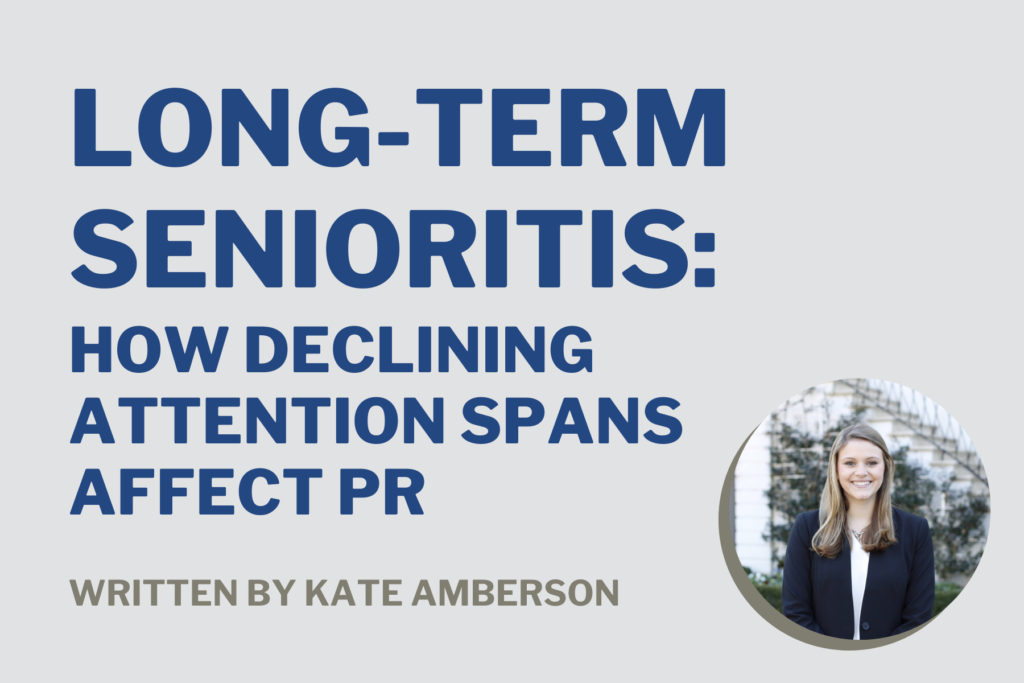Long-Term Senioritis: How Declining Attention Spans Affect PR

In February 2020, I was a thriving high school senior about to go to my first prom and start studying for my Advanced Placement exams. I maintained a 4.0 GPA while lettering in three sports and being a co-editor of the yearbook, and I could still be in bed by 11 p.m. When I heard we might get a few days off of school, the “senioritis” that was boiling over in me made me ecstatic for a break.
Then we never went back.
Flash forward to today, nearly a year removed from the COVID-19 pandemic, and I can hardly go 15 minutes without “taking a break” and mindlessly staring at my phone for hours on end. The “senioritis” never quite wore off, and the pandemic definitely did not help. Therefore, my attention span is at an all-time low, and it’s not just me who’s struggling.
So, what exactly is happening?
In the past 10 years, there has been a “consistent increase in ADHD diagnoses,” said the Health publication. According to the Centers for Disease Control and Prevention, using data from 2016–2019, “the estimated number of children aged 3–17 years ever diagnosed with ADHD is 6 million.”
The prevalence of attention-deficit/hyperactivity disorder in adults living in the U.S. was 4.4% from 2001–2003, which is 10.5 million people, according to The Center for Advancing Health. While ADHD is not solely being unable to focus on a task at hand, being easily distracted certainly plays a significant role in the neurodevelopmental disorder.
To clarify, I’m not saying that we all have ADHD now because of the COVID-19 pandemic. However, I am saying that there seems to be an increasing group of individuals who struggle to focus or stay motivated. Some people came out of the pandemic ready to make a change, go outside and do big things, while the rest of us fought the battle of simply getting out of bed.
While the CDC explained that research does not support environmental factors or the frequent use of technology causing ADHD, the increase in screen time and the decrease in social interaction could not have been beneficial. The pandemic did lead to a rise in ADHD awareness as well as telemedicine appointments.
Now there’s even an Adderall shortage. The Washington Post attributed the deficit to a 30% surge in Adderall prescriptions “over the past five years and accelerated during the pandemic,” among other factors.
How does this affect the public relations universe?
With an increasing percentage of the U.S. population experiencing ADHD, and some struggling to receive medication, public relations professionals must be wary of shortening attention spans. TikTok and Instagram Reels allow professionals to connect with an extensive audience that consumes a sizable amount of content through video marketing. While platforms like TikTok allow organizations to get a message across quickly, one must do so effectively; and this route is only a strategic fit for some organizations.
Creating quality content that will attract target audiences is much more critical than simply creating an abundance of content that might not be as impactful. Interactive content also can engage individuals with ADHD or short attention spans.
Whether crafting an email, press release or speech, you should have a clear objective in mind so that you can stay concise and be impactful with what you are trying to communicate.
Although the pandemic might be over, it still has lasting impacts. As public relations professionals, we must do everything we can to gain the attention of our target audiences. To do so effectively, professionals must create relationships with their audiences and genuinely understand their wants and needs.
Kate Amberson is a junior at The University of Alabama. She is majoring in public relations with a minor in Spanish. She will continue her education in the fall in UA’s Accelerated Master’s Program. Working at a summer camp, giving a TED Talk, and serving on campus as the vice president of inclusion for the Zeta Chapter of Kappa Delta, Kate recognized that her passion for public relations stems from human connection. You can connect with Kate via LinkedIn.

